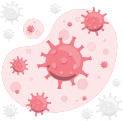In its early stages, liver damage often does not present noticeable symptoms. Some forms of mild liver damage can be managed with dietary and lifestyle modifications, while others require lifelong medical treatment. Early intervention can help prevent irreversible damage that may lead to severe health complications. What are the warning signs of liver damage? Read on to learn more.
Signs of Liver Damage
The liver is the second-largest organ in the human body and plays a vital role in several functions, including bile production for digestion, energy storage in the form of glycogen (which is later converted into glucose), and toxin filtration.
Liver damage can result from various factors, such as drug toxicity, excessive alcohol consumption, or viral infections. In many cases, early-stage liver damage does not exhibit clear symptoms. At this stage, liver abnormalities are typically identified through blood tests, liver function assessments, and complete blood counts.
Over time, liver dysfunction can lead to fibrosis, or scarring of liver tissue, which impairs its ability to function properly. At this point, the body may begin to display signs of liver damage.
Some indicators of liver damage to be aware of include:
Jaundice
Jaundice causes a yellowish discoloration of the skin and the whites of the eyes due to elevated bilirubin levels in the bloodstream. Another telltale sign of jaundice is dark brown urine, as bilirubin is excreted through the kidneys. Jaundice can be an early indication (or in some cases, the only sign) of liver dysfunction.
Cholestasis
Cholestasis occurs when bile flow from the liver slows or becomes obstructed. As a result, bile accumulates in the bile ducts and liver, leading to irritation and impaired function. When bile leaks into the bloodstream, it can have toxic effects on the body. Symptoms of cholestasis include persistent itching, pale-colored stools, and abdominal pain.
Liver Enlargement (Hepatomegaly)
Hepatomegaly, or liver enlargement, is not a disease in itself but a sign of underlying conditions such as liver disease, congestive heart failure, or liver cancer. This condition may cause persistent bloating or discomfort in the abdominal area.
Ascites
Ascites refers to the accumulation of fluid in the abdominal cavity due to fluid leakage from the liver and intestines. It is characterized by noticeable abdominal swelling, discomfort, and difficulty breathing.
Several conditions that can contribute to ascites include cirrhosis, alcoholic hepatitis, hepatic venous obstruction (blockage in liver veins), and disorders affecting other organs in the body.
Esophageal Varices
Esophageal varices occur when veins in the esophagus become enlarged, typically as a result of severe liver disease such as cirrhosis. This condition often remains asymptomatic until complications arise. Symptoms may include vomiting blood, black or tar-like stools, weight loss, itching, and muscle cramps.
Hepatic Encephalopathy
Hepatic encephalopathy is a neurological disorder caused by the accumulation of toxins in the bloodstream that the liver is unable to process. This condition affects brain function and can lead to nervous system damage.
Symptoms of hepatic encephalopathy include:
- Reduced awareness and alertness
- Impaired reasoning, personality shifts, and behavioral changes
- Mood disturbances
- Excessive drowsiness
- Confusion and disorientation
- Loss of consciousness
Liver Failure
As liver damage progresses to an advanced stage, it can lead to liver failure, a condition in which the liver loses its ability to perform essential functions.
Liver failure develops gradually over time, with progression varying depending on the severity of the damage. In cases where the liver can no longer sustain bodily functions, a liver transplant may be necessary.
Liver damage does not always present with noticeable symptoms, making early detection crucial for timely medical intervention. If you have concerns about liver health, it is advisable to consult a doctor or use the Ai Care application’s consultation feature, available for download on the App Store or Play Store.
Looking for more information about other diseases? Click here!
- dr Nadia Opmalina
John Hopkins Medicine. Common Characteristics of Liver Disease. Available from: https://www.hopkinsmedicine.org/health/conditions-and-diseases/common-characteristics-of-liver-disease
Mayo Clinic. Liver Disease. Available from: https://www.mayoclinic.org/diseases-conditions/liver-problems/symptoms-causes/syc-20374502
Cleveland Clinic. Liver Disease. Available from: https://my.clevelandclinic.org/health/diseases/17179-liver-disease
Gurarie, M. (2024). Signs of Liver Damage and Ways to Tell. Available from: https://www.verywellhealth.com/signs-of-liver-damage-8665825#












